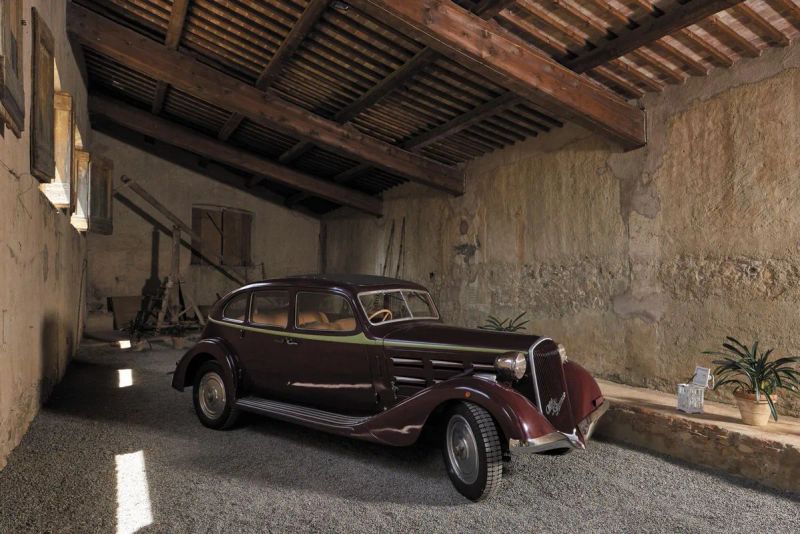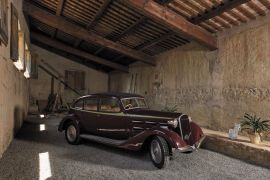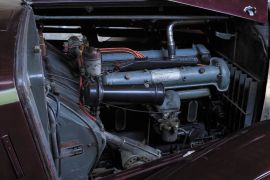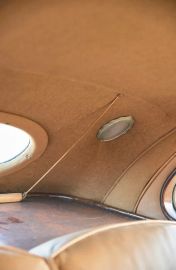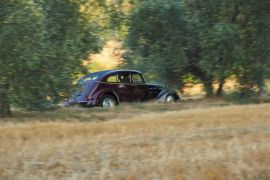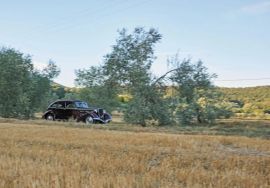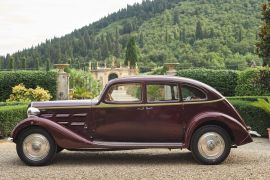ALFA ROMEO 6C 2300 TURISMO (1935)
CHASSIS N. 710566
ENGINE: IN LINE 6 CYLINDER TWIN-CAM
DISPLACEMENT: 2309 CM3
POWER: 68 CV
BODY STYLE: SALOON “SOFFIO DI SATANA” BY TOURING
ALFA ROMEO
Cavaliere Vittorio Jano (1891-1965) was a pivotal figure in Italian Motoring history: the protagonist of the great season of Fiat victories in the 1920s, he shaped Alfa Romeo and made it the most loved, envied and desired Italian brand in the world in the years between the two world wars. He also made the rebirth of Lancia possible after the death of the Founder and brought it the highest sporting honours, and made an important contribution to the creation of the Ferrari legend.
Dr. Giuseppe Merosi was Alfa Romeo’s technical manager in the early 1920s. In 1920 a young driver joined the team, a certain Enzo Ferrari from Modena.
It was Ferrari who contacted Jano and convinced him to leave Fiat and join Alfa Romeo. Later he would say of him: “- ... he was a man of great ability with great technical intuition. He was not a mathematician but he was particularly cultured having trained as a simple high-school technician. But he had the humility to contact ... a professor of mathematics in Milan who kept him up-to-date on all the calculations that might be necessary to him ...-“ (Le Alfa Romeo di Vittorio Jano, A.T. Anselmi e V. Moretti, Autocritica, 1982).
The Portello plant was one of the most advanced factories in the industry particularly with regard to the foundry, the precision mechanics and the use of alloys and special processing. As soon as he arrived there, in 1922, Jano got to work and the first thing he produced was immediately a masterpiece: the P2 which, by winning the European and World Championships, resulted in the laurel wreath being added to the Alfa Romeo viscount Brand logo. Soon afterwards the 6C 1500 model was born, starting the highly successful family of touring, sports and racing vehicles that would continue until the early 1950s with the 6C 2500, to which the 6C 2300 we are auctioning today belongs.
THE 6C 2300
Various versions of the 6C 1500 were developed and it was transformed into the 1750, 1900, 2300 and, finally, the 2500. In parallel, the fabulous 8C 2300 and 2900 were born and recognized as the best sports cars in the world.
The 6C 2300 model that we are looking at first saw the light at the Milan Motor Show in 1934, following the many years of sporting and commercial success of the previous series. Whilst originating from the previous 6C vehicles, this version arose from a totally new design in which the distribution, still moved with double overhead cams, was chain-driven and no longer gear-driven in order to offer greater silence and reliability. The gearbox had a synchronized third and fourth gear and an interesting ‘free wheel’ mechanism that had been tested on the 1900. The front suspension was the same as on the prestigious 8C 2300. It was the last Alfa Romeo to have rigid axles and leaf spring suspensions which were abandoned on the subsequent 6C 2300B version.
THE CARROZZERIA
The 6C 2300 was conceived with a less sporty manner compared to the previous models and often featured comfortable, spacious bodywork rather than being racy. The bodywork of many of the cars was fitted in-house, whilst others were “dressed” by the top specialists of the time such as Castagna, Pinin Farina, or Touring. Thanks to this coachbuilders, the 6C 2300 received many prestigious awards at the Concours d’ Elegance of the time, including the Pincio in Rome, the Valentino in Turin and, naturally, at Villa d’Este.
Carrozzeria Touring was founded in Milan in 1926 by Felice Bianchi Anderloni and Gaetano Ponzoni, two professionals from the upper Milanese bourgeoisie, who managed to interpret the town’s characteristics of reserved yet self-assured elegance better than anyone. It was the youngest bodywork company in the post-war period: in fact, in 1934, when it realized the vehicle presented here, it was only eight years old. However in those eight short years it had already established itself as one of the most important Italian and global designers, capable of offering innovation in terms of both aesthetics and technology.
For Bianchi Anderloni line and technique always went hand in hand: in fact he was one of the first people to study the effects of aerodynamics on vehicle efficiency, as well as on fashion and public tastes, as is evident from a study of the unusual bodywork, christened “Soffio di Satana” (Devil’s Breath) that characterizes this car. It offers a glimpse of foreign inspiration from France and even from the Chrysler Airflow, however the success of this body style lies in the perfection of the volumes and in the simple elegance, without any pointless frills.
This is an early example of the ‘Sports Saloon’, halfway between the heavy six light saloons of the time and the coupé models, and perfectly interprets the Alfa Romeo 6C 2300 Turismo chassis. Only two of these cars were built, one of which is here in front of you today.
THE 6C 2300 NO.710.556 AND ITS UNIQUE STORY
This example was known about but believed to have disappeared according to historians featuring, amongst others, Angelo Tito Anselmi and Carlo Felice Bianchi Anderloni, who discussed it in various books they curated including “Le Alfa Romeo di Vittorio Jano” and “Carrozzeria Touring”, both published in 1982.
People only believed that the vehicle had disappeared because its owner never used it for rallies, shows and elegance contests, but rather kept it jealously to himself for over fifty years.
Having described the car, its technical and stylistic features and its lineage, we now have the thankless task of writing a few notes about this vehicle’s first owner, a man whose influence was second to none not just in the small history of this automobile, but in the History of this entire Country, not to mention of Literature.
The original registration documents that accompany this Alfa Romeo certify that it was sold by the Company, on 12/4/1935, to Commander Gabriele d’Annunzio, Prince of Montenevoso.
It is certainly not up to us to describe the Man and his life, it is enough to say that in 1935 he had experienced very many battles – some real and others just described by him, and that he lived in his castle-mausoleum in Gardone Riviera receiving all types of personalities, just like a Ruler. A 72 year old man, which was a good age at that time, especially for someone who had always lived life to the full.
D’Annunzio had always loved beautiful cars and Alfa Romeos in particular. At times he entertained his neighbour from Mantova, Nuvolari, and they talked about engines... and possibly about other things as well. It was D’Annunzio who, many years earlier, decreed that “Cars are female”.
In addition to Alfa Romeos, he loved and often used Isotta Fraschini vehicles, one of which is still preserved at the Vittoriale. Many of them were sold by his son, Gabriellino, who represented the Milanese Company in the United States. Therefore we can say that, unlike many other more ascetic artists, he – a lover of beauty and luxury - knew and loved beautiful cars, and definitely used them as part of that whole symbological display that increased his aura and fame.
The Alfa Romeo we are presenting today was therefore in use at the Vittoriale in the last three years of the Bard’s life. It was used for personal trips and for welcoming some guests at the Desenzano station. With regard to the former, very few of these have been recorded since they were often clandestine, but many took d’Annunzio to Verona to meet the publisher Arnoldo Mondadori in order to check on the production of his books and ask for advance payments; Piero Chiara, in his “Vita di Gabriele d’Annunzio” (Mondadori, 1978) recounts as an example that, on 26 August 1937, d’Annunzio went to collect Ugo Ojetti (a journalist, scholar and Italian Academic), but also that the planned trip to Venice the next day was cancelled due to his weakness. Possibly one of the last journeys was the one at the end of July 1937, around six months before his death, which took the Bard, accompanied by his close collaborator Moroni, to Parma and to Verona.
The copious documentation accompanying the vehicle includes an extremely valuable notebook, the “Ruolino di Marcia” [Route Log] where the kilometres driven and the maintenance work carried out are all noted down.
The following information is provided:
- 2/7/36 13,625
- 11/8/36 15,974
- 14/9/36 17,629
- 23/12/36 21,254
- 8/2/37 24,290
- 20/4/37 27,259
- 22/6/37 30,008
- 17/8/37 33,024
- 7/9/37 35,305
- 15/10/37 37,740
- 9/11/37 40,760
- 15/1/38 43,090
- 1/5/39 47,120
Considering the state of the Bard’s health, it would be reasonable to think that most of the driving, or a significant part of the same, involved – more than travel by the Bard himself - errands, the transporting of guests and the delivering of messages that the illustrious owner produced and received in great quantities and that it was often not prudent to entrust to the services of the Italian Royal Mail.
However this “Ruolino di Marcia” also gives us an idea of how the Alfa Romeo was used quite regularly and carefully looked after: each date corresponds to an oil change and, on one occasion, the grinding of the valves. In the spring of 1937 the “Fondazione del Vittoriale degli Italiani”, was set up in agreement with the Bard who intended it “to save the Vittoriale from the clutches of greedy and cynical heirs” (Chiara, op. cit.), and the ownership of the Alfa Romeo was transferred to this Fondazione on 17/2/1940. However on 5th August 1946 the Alfa Romeo was purchased by the Società Autotrasporti Industriali of Busto Arsizio, thus losing its original number plate - BS 10764 - and acquiring the VA 18580 number plate that it still has today.
In April 1963 the 6C 2300 was purchased by two young brothers from Castellanza, in the province of Varese who have kept and looked after the vehicle until now. This car became part of their family life and was used rarely for special occasions or family ceremonies: for this reason it remained off the radar to traders and collectors and today is being presented again to a world which, in the meantime, had consigned its first owner to history and has recognized the value of great cars and, in particular, those like this one that have maintained their total originality and are, therefore, able to convey the work and brilliance of the people who created them to future generations.
The vehicle is completely original except for the speedometer which was replaced many years ago with a similar Jaeger one that has a white rather than black dial. It has never been resprayed or refinished, but the pillarless ‘suicide’ rear doors still work perfectly after eighty-three years and are impeccably aligned: recognition of the high value of the work of the Carrozzeria Touring engineers.
This Alfa Romeo 6C 2300 Turismo, with its wonderful “Soffio di Satana” Touring bodywork, original condition and exclusive history, is a uniquely rare car that would enrich any collection. It is a vehicle which can be immediately projected to the highest and most exclusive levels of collecting and events dedicated to the same, guaranteeing the next future lucky owner a place in the limelight anywhere, from the Mille Miglia to Pebble Beach, not to mention Villa d’Este.
For an enthusiast and collector of D’Annunzio memorabilia, this offers a unique occasion to own a car that belonged to the Commander – seeing as it is unlikely that the vehicles displayed at the Vittoriale will ever leave the Fondazione - and to use a vehicle that once transported the Bard and many other people, some of whom have passed into history and others who have been carefully concealed, people who kept d’Annunzio company at the end of his life. A life that was planned and lived like a Work of Art, just like the Alfa Romeo you have before you.
The vehicle is in excellent mechanical condition but, for safety reasons, we advise the purchaser to have it checked over and to replace the fluids, filters and perishable elements.

